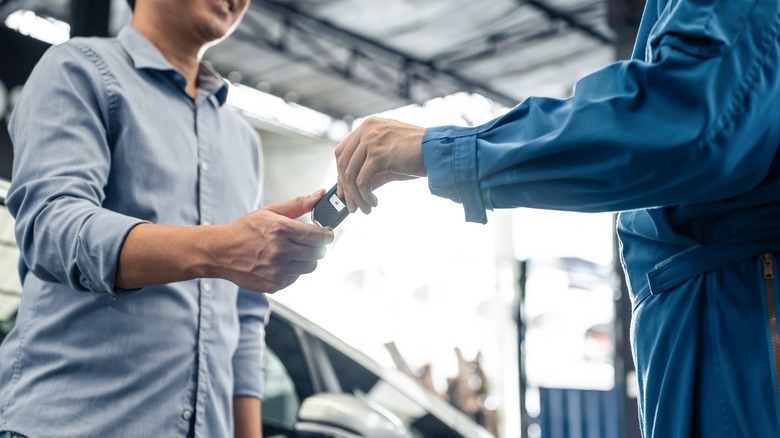The Hidden Costs Of Buying A New Car That You Need To Know
Buying a brand-new car is an exercise in wonder and dreams. From start to finish, the experience of purchasing a new vehicle leads to researching products, car dealerships, and a smattering of beautiful, sparkling vehicles that get the imagination running in high gear — such as newer electric vehicles with enough range for a long commute or the latest and greatest cars of varying luxuriousness from manufacturers all over the world.
When purchasing a car, the cost is often one of the most important factors in determining which vehicle you're driving home and calling your own for many years to come. But the sticker price isn't all you'll pay throughout your car's lifetime. AAA notes that taxes, registration, fuel, and other fees always come along with the ownership of a new vehicle, with costs in 2022 rising to $894 per month.
However, even these aren't the only expenses that you'll have to think about when calculating the total cost that a new car will bring. Maintenance costs alone will form an ongoing expense in your budget, and this is unavoidable regardless of the vehicle that you choose to drive. However, vehicle depreciation and the weight of your financing decisions play an even bigger role in the overall price tag that will ultimately sit alongside the car in your driveway.
Maintenance requirements can be large or small
Maintenance is one of the most important aspects of your life as a car owner. In order to continue driving a car that performs at its best and always gets you where you need to go, you'll need to bring the vehicle into the shop from time to time for oil changes, tire rotations, engine checks, and much more.
Every component in a car is precisely engineered to work within a set of specific parameters. Over time, parts will wear out and fluids will need to be replaced. Popular Mechanics reports that the typical car owner will likely need an oil change twice a year if their vehicle runs on standard oil and at least once if it relies on synthetic.
Maintenance costs will fluctuate from year to year, and a lot of this has to do with luck of the draw. You might experience multiple tire punctures over the course of a year, or you may see no substantial problems with the vehicle at all for an extended period of time. The Balance notes that the average yearly cost of maintenance for American drivers is around $1,000. However, this price tag can fluctuate wildly based on the make, model, and age of your vehicle. High-end cars often require more expensive parts, and some older, classic cars might experience a scarcity of available replacement parts, leading to inflated costs for fixing your vintage car.
Vehicle depreciation is a significant weight
When you purchase a new car, it immediately begins to lose value. Unlike collectibles, stocks, or your home, which typically benefit from a boost in value over time, cars experience the opposite. The erosion of value in the automotive space comes as a result of a vehicle's generally limited capacity to perform its function. If any purchase adds up roughly to the sum of its parts, then the purchase of a car represents the decision to buy a piece of equipment that will inevitably be replaced.
A home may one day be demolished so that a new property can be built on the land, but this reality is far from inevitable. Vehicles are destined for the scrap yard from the moment they are rolled off the assembly line, a big problem facing the millions of electric cars with batteries at the end of their lifespan.
What you are buying is the ability to transport yourself for a limited time. That length of time is influenced mainly by you, the owner. It's entirely possible for you to take possession of a new vehicle, drive out onto the roadway from the dealership's parking lot, and promptly get sideswiped by another driver. Cars Direct notes that a vehicle loses 15% to 20% of its value the moment it leaves the lot under your control. Car ownership boils down to a bet that the vehicle will perform for long enough to make the investment worthwhile.
Financing a purchase adds to the total dollar amount, sometimes substantially
Another overlooked component of car buying is financing. Most buyers won't be purchasing a new vehicle from the dealership in cash. Statista notes that almost 84% of new auto purchases include financing agreements. New cars are substantially more expensive than used vehicles (at least 15% to 20%), so these typically require a loan. At least vehicle financing rates are more favorable when compared to other types of personal loans. ValuePenguin reports that the average auto loan rate is 5.27% over 60 months.
It's easy to forget that financing is a tool to defray the cost of the purchase over a longer time, but this adds an additional cost to your purchase. Borrowing is often misunderstood by everyday consumers. Instead of thinking of a loan as a helpful way to pay for purchases, you should instead think of it as buying money. In essence, you are buying the funds required to purchase your vehicle and then paying back both the funding and the expense over the long term. The longer it takes you to pay back the loan, the more expensive it becomes. For example, a 10% interest rate on a $10,000 loan adds $1,000 to the cost over the course of a year. Over two years, this interest adds up to $1,100 (without considering repayments, of course).
If you aren't diligent in repaying your loans as quickly as possible then the price of your new car can quickly multiply.



